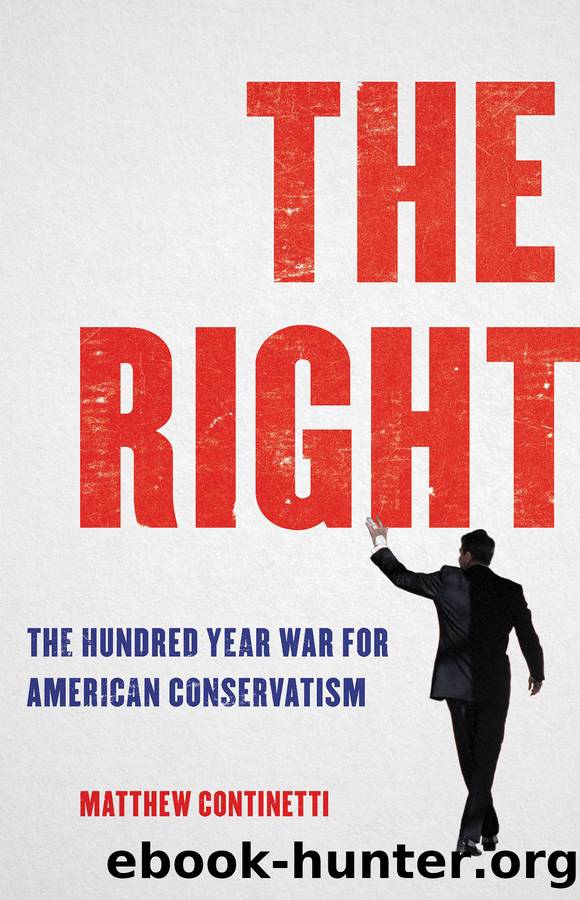The Right by Matthew Continetti

Author:Matthew Continetti [Continetti, Matthew]
Language: eng
Format: epub
Published: 2022-04-19T00:00:00+00:00
THE CARTER PRESIDENCY CATALYZED THIS RIGHTWARD SHIFT. IT allowed the GOP to move beyond the Nixon-Ford years. Its failures against inflation, crime, and the Communists boosted Reaganâs fortunes in 1980. Perhaps most significantly, the Carter years created the space for conservatives and neoconservatives to formulate new approaches to contemporary problems.
A lot of this work happened inside the conservative infrastructure that was slowly taking shape in Washington. Think tanks long had been safe havens for policy wonks whose party was out of the White House. The American Enterprise Institute was unique in the late 1970s in that, in addition to Republican veterans of the Nixon and Ford administrations, including President Ford himself, neoconservatives began to fill its offices.
AEI president Bill Baroody and Irving Kristol had become fast friends. They shared an interest in philosophy and religion. And this interest motivated Baroody to enlarge AEIâs fields of study beyond economics and foreign policy and into political and social thought. That was why Kristol spent a sabbatical at AEI during the 1976â1977 academic year and why Baroody began to recruit Democratic intellectuals, such as Ben Wattenberg and Georgetown political scientist Jeane Kirkpatrick, whose dissent from the counterculture had left them politically homeless.28
AEI was a meeting ground for intellectuals and policymakers. When President Ford had wanted to use the nationâs bicentennial to remind Americans of the republicâs enduring principles, he turned to his friend and adviser Robert C. Goldwin, a former president of St. Johnâs College in Annapolis who had a close affiliation with AEI. The think tank held a symposium on Americaâs founding that brought together Irving Kristol, Martin Diamond, Ed Banfield, Robert Nisbet, and others for lectures at Independence Hall in Philadelphia. In a memo to Fordâs staff, Kristol recommended that they review the transcripts of the symposium, in particular his and Diamondâs emphasis on the distinctiveness of the American revolution. It was the one modern change of regime, Kristol said, that did not end in nihilist terrorism. Kristol also urged Fordâs staff to emphasize the exceptional nature of American government and society, especially its openness to immigration. âThe success of this enterprise,â he wrote, âreveals both the universality of the political ideas on which the U.S. was founded, and their realism.â29
The neoconservative network centered on AEI grew quickly. Among Kristol and Baroodyâs recruits was theologian Michael Novak. Born to immigrant Slovak parents in Johnstown, Pennsylvania, Novak had attended a Catholic seminary but decided against a vocation. He studied at Catholic University and then at Harvard. He covered the Second Vatican Council as a journalist, leading to his book The Open Church (1964). But as he delved into radical thought and politics, Novak never lost sight of his roots in the ethnic working class.
Novak was a dashing, thirty-three-year-old Stanford professor of religion when he traveled to Cuernavaca, Mexico, in 1966. There he taught alongside Richard John Neuhaus, the activist Lutheran pastor of a majority black church in Brooklyn, and Peter Berger, the conservative-leaning sociologist who also participated in the antiwar movement. This trio of left-wing intellects wound up imbuing capitalism with moral and religious substance.
Download
This site does not store any files on its server. We only index and link to content provided by other sites. Please contact the content providers to delete copyright contents if any and email us, we'll remove relevant links or contents immediately.
Harry Potter and the Goblet Of Fire by J.K. Rowling(3024)
Unfinished: A Memoir by Priyanka Chopra Jonas(2911)
Never by Ken Follett(2872)
The Man Who Died Twice by Richard Osman(2289)
Machine Learning at Scale with H2O by Gregory Keys | David Whiting(2264)
Fairy Tale by Stephen King(2058)
Will by Will Smith(2032)
Rationality by Steven Pinker(1760)
The Storyteller by Dave Grohl(1656)
The Dawn of Everything: A New History of Humanity by David Graeber & David Wengrow(1564)
The Dark Hours by Michael Connelly(1562)
The Stranger in the Lifeboat by Mitch Albom(1529)
Cloud Cuckoo Land by Anthony Doerr(1428)
The Becoming by Nora Roberts(1323)
Friends, Lovers, and the Big Terrible Thing by Matthew Perry(1321)
Crying in H Mart by Michelle Zauner(1312)
Einstein: His Life and Universe by Walter Isaacson(1311)
New Morning Mercies: A Daily Gospel Devotional by Paul David Tripp(1301)
A Short History of War by Jeremy Black(1295)
